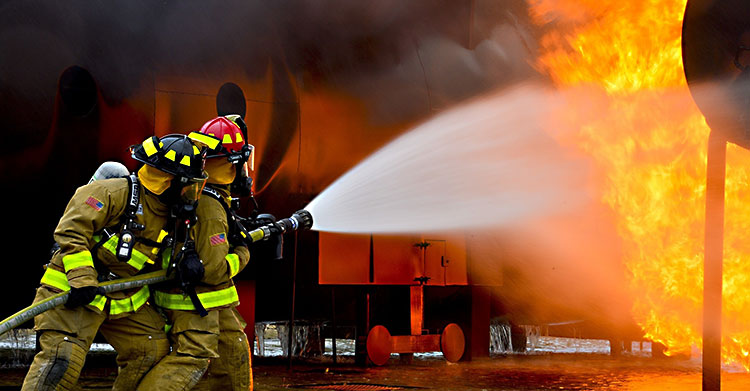by FireSafe Santa Cruz Education & Outreach Committee
Could firefighters find your home in the middle of the night and protect it from an advancing wildland fire?
Use the time you may now unexpectedly have available due to the coronavirus shelter-in-place orders to work around your home and driveway.
1) Finding your home
If you live in a rural area, make sure your primary access road is identified with a non-flammable sign and that your road’s name appears in at least 4” reflective green background white reflective letters visible from both directions of travel.
Install signs showing street numbers with directional signs at all driveway splits.
The addressing standard is found here: www.santacruzcountyfire.com/fire_marshal/standards/fpo_016_addressing_standard.pdf.
2) Accessing your home
County Fire Codes specify that all roadways be 20’ wide ; however , driveways serving up to two homes may be 12’ wide. Vertical clearances of 15’ must be maintained to provide safe access for fire engines responding to your home.

Access roads and driveways that are 12’ wide need turnouts 12’ wide and 35’ long every 500’. This will prevent a fire engine from getting blocked when responding to your home at a time when you and your neighbors are attempting to evacuate
Fire agency turnout standard is found here: www.santacruzcountyfire.com/fire_marshal/standards/fpo_013_turnouts.pdf
Clear all flammable vegetation 10’ horizontally along access roads and driveways to prevent a fire from starting at the road and escaping into the wildland. This will also reduce fire hazards for responding fire engines.
Maximum grade and vertical clearance standard is found here: www.santacruzcountyfire.com/fire_marshal/standards/fpo_012_max_grade_vert_clearance.pdf
Contact the FireSafe Santa Cruz Council for free chipping programs: www.firesafesantacruz.org/no-cost-chipping
Does your driveway include a private bridge? Fire engines require a bridge be 20’ wide and be certified by a licensed and qualified engineer to make sure it is safe for heavy units responding to protect you and your home.
Bridge load limit signs are required and the bridge must be recertified every ten years: www.santacruzcountyfire.com/fire_marshal/standards/fpo_008_bridge_load_limit_signs.pdf
Can a fire engine safely turn around in your driveway? All driveways leading to structures 150’ from the main roadway must provide turnaround spaces, either T-style with a 16’ entry, or a circular space with minimum 40’ center line radius.
Turnaround standards required by fire agencies is found here: www.santacruzcountyfire.com/fire_marshal/standards/fpo_015_turnarounds_2.pdf
Is your driveway is secured by a gate? For fire engine access, the gate can be no farther than 30’ from the public roadway and must be two feet wider than the driveway. If the gate is locked, you need to provide a key or code access for firefighters to open the gate and access your home quickly.
The Santa Cruz County Fire gate standard is found here: www.santacruzcountyfire.com/fire_marshal/standards/county_gate_standard.pdf
3) Is there a water source available for fire responders to protect your home?
Provide clearly-visible reflective signage to help firefighters find your water sources in the middle of the night so that they can quickly and safely defend your home.
You can obtain free blue reflective street dots: Santa Cruz County Fire Marshal’s Office (831) 335-6748.
4) Does Your Community Have a Secondary Access Route?
There is new law regarding secondary access for communities in high fire risk areas where there is no secondary access. Public Resources Code 4290.5 became effective January 1, 2020 and states:
“On or before July 1, 2021, and every five years thereafter, the State Forestry and Fire Protection Board, in consultation with the State Fire Marshal, shall survey local governments, including counties, cities and fire districts, to identify existing subdivision (communities of 30 or more residences) located in a state responsibility area or a very high fire hazard severity zone, without a secondary egress route that are at significant fire risk.
The Board, in consultation with the State Fire Marshal and the local government that identified the subdivision, shall develop recommendations to improve the subdivision’s fire safety.
The recommendations may include, but are not limited to creating secondary access to the subdivision improving the existing access road or other additional fire safety measures.
The Board must maintain a list of these at-risk subdivisions and reports on the status of the work being done to reduce the risks.
Contact your local fire agency today if you live in a neighborhood with no secondary access for fire evacuations.”
You can find good information about fire defensible space here: https://www.firesafesantacruz.org/defensible-space
Do what you can to improve firefighters’ fire engine access to your property, and to reduce fire risk now while we are all still sheltering in our yards.